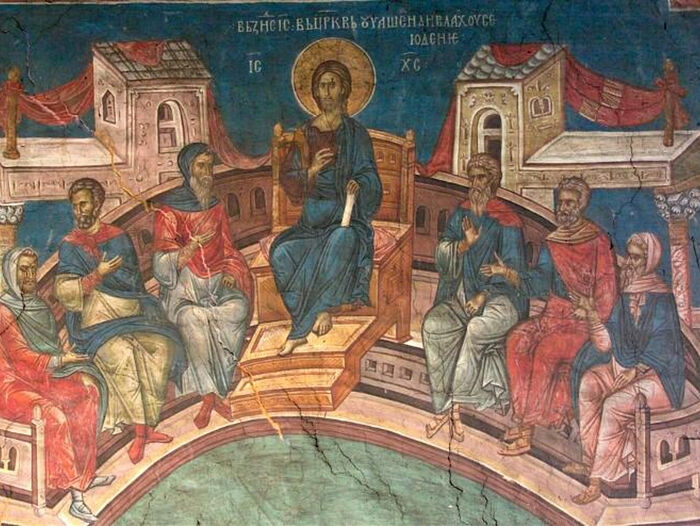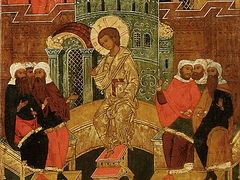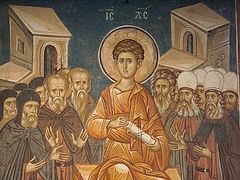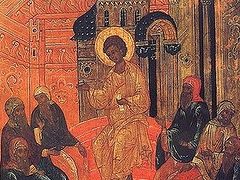The Feast of Mid-Pentecost is one of the most ancient Church holidays. For example, the Holy Hierarch St. John Chrysostom, a great saint and the teacher of the Church talks about it in the fifth century. As such, the word “mid-feast” means “the middle”: It celebrates the mid-point of the fifty days from the day of the Bright Resurrection of Christ to the day of the Ascent of the Holy Spirit on the apostles, the Holy Pentecost.
These two great feasts mark the most significant milestones in the history of mankind: the Resurrection of Christ, His victory over the man’s death and oblivion, and the coming of the Comforter, the Spirit of Truth, God the Holy Spirit to us people. That’s how the meaning of the deed and the sacrifice of our Lord Jesus Christ committed for the sake of mankind is revealed. Because God the Son, God the Word has come in flesh like one of us, so that we could be saved from eternal death and be filled with life, connecting us inextricably with the Holy and Life-Giving Spirit.
Father, Son, and the Holy Spirit are the One and Undivided Trinity, our God, the source of life, happiness, and all goodness. Because of Communion of the Body and Blood of the Lord and becoming the vessels of the Holy Spirit, we are inseparably connected with Triune God.
So, the Church marks a halfway point between these two ultimate events with a special feast—the midpoint of joyful anticipation.
In general, the midway point is always a special kind of a milestone. It calls us to look back at the distance traveled and take a closer look at the path lying ahead of us (it is no coincidence that Dante’s “The Divine Comedy,” the literary work full of deep Christian meaning, begins with the line: “Midway this way of life we’re bound upon…”). It is also reflected in the liturgical Church practice as well: The midpoint of Great Lent is marked by the Veneration of the Cross Sunday, a special celebration honoring the Cross of the Lord in order to support those who labor in fasting, whereas the midpoint between two major pinnacles in human history is marked by the feast of Mid-Pentecost.
“An avid traveler aiming for his destination is ever so happy to call to mind how much of his journey he has already completed, and he is thereby made stronger to complete what remains; his strength is renewed, and therefore now with solemn joy and devotion we observe this day (Mid-Pentecost—E.M.) which tempers and moderates the ardor of our anticipation, so that with our minds refreshed we may arrive at the grace and happiness of the Holy Spirit” (St. Peter Chrysologus, fifth century).
This feast is deeply rooted in history. The Gospel describes how, in the third year of His ministry, Christ went to the Temple and taught in the middle of the Old Testament Feast of Tabernacles. On the last day, that great day of the feast, Jesus stood and cried out, saying, “If anyone thirsts, let him come to Me and drink. He who believes in Me, as the Scripture has said, out of his heart will flow rivers of living water.” But this He spoke concerning the Spirit, whom those believing in Him would receive; for the Holy Spirit was not yet given, because Jesus was not yet glorified (John 7:37–39).
At the same time, one of the few known events from Christ’s childhood also took place on the feast of the Tabernacles, when the Mother of God and St. Joseph the Betrothed lost sight of Jesus on their way from Jerusalem, but after three days they found Him in the temple, sitting in the midst of the teachers, both listening to them and asking them questions. And all who heard Him were astonished at His understanding and answers (Luke 2:46-47).
The Feast of Tabernacles was one of the ancient national Jewish festivals established to commemorate the time the Israelites spent in the “booths” (tents) during their wandering in the desert. Our feast of Mid-Pentecost may be called a historical heir and a “direct descendant” of that ancient feast celebrated by God’s chosen people.
The feast lasted for eight days, the first and last days of which were of particular significance. On the last, or eighth, day of the celebration the Israelites performed the rite of the ceremonial pouring of the water, an Old Testament foreshadowing of the outpouring of the Holy Spirit on the faithful as promised by Christ. That’s what we celebrate on the feast of Mid-Pentecost: Christ’s assurance of the gift of the Spirit. In commemoration of the grace of the Holy Spirit that the Savior likened to the life-giving water, the Church conducts the blessing of the water on this day and prays “about filling all those who thirst salvation with the waters of godliness.”
Like any other great Church feasts, it is celebrated over the period of seven days. Mid-Pentecost has its leave-taking day. Leave-taking, or the last and typically the eighth day of the feast, is celebrated just as ceremoniously as the beginning of the feast.
The Apodosis, or “leave-taking,” is translated from Greek as “what comes after.” It is the day of return with one’s heart and mind to the meaning and essence of the event we celebrate. In order to appreciate or understand the gift bestowed upon him, man oftentimes has to give it up or give it away.




